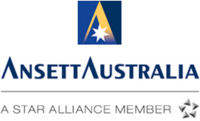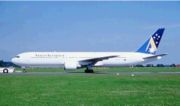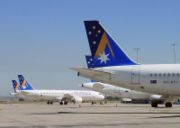澳大利亚安捷航空公司
出自 MBA智库百科(https://wiki.mbalib.com/)
澳大利亚安捷航空公司官方网站网址:http://www.ansett.com.au/
目录 |
安捷航空(Ansett Australia 或 Ansett)是澳大利亚重要的国内和国际航空公司。2002年公司因为财政问题而破产,后来它的大多数资产用于偿还了债务。这家航空公司共经营66年。
让澳大利亚人备感伤心的是,创造出66载傲视群雄辉煌历史的澳大利亚第二大航空公司 ――澳大利亚安捷航空公司(Ansett Australia简写为“AN”),难以抵御接二连三“停飞事件”的重创,无可奈何地于2002年3月5日宣告倒闭破产,一步三回头地退出了澳大利亚航空业的竞争舞台,含泪忍悲地结束了自己那遨游长空振翅飞的“蓝天生涯”。
为何曾令澳大利亚人无比自豪的“澳大利亚安捷航空公司”,竟会在短短的两年时间内由虎虎生气的“悉尼奥运会指定航空运营商”,蜕变为有气无力的“澳大利亚航空业失意人”?无论从哪个角度来找寻“澳大利亚安捷航空公司”衰败的成因,“不会念经的歪嘴外来和尚”――新西兰航空公司46岁的CEO加里・托米都脱不了干系。加里・托米那“生命诚可贵,信誉价更高,若为利润故,二者皆可抛”的钻牛角尖昏招,迫使“澳大利亚安捷航空公司”难以摆脱因安全原因而不得不经常停飞所造成的重重阴影,久而久之因失信于众多乘客而自毁信誉,极不情愿地走上了“飞机趴窝难高飞”的倒闭破产不归路,惨兮兮地扮演了环球航空业界第一个因安全原因而歇业的不光彩角色。
两度停飞 吞咽忽视安全苦酒
“澳大利亚安捷航空公司”,由一位名叫安捷的澳大利亚爵士于1936年创建。仅仅经过34年的快速发展,“澳大利亚安捷航空公司”就脱颖而出成为与澳大利亚航空业“第二大杀手”――澳大利亚快达航空公司平分秋色的强硬竞争对手。20世纪80年代,安捷爵士将“澳大利亚安捷航空公司”卖给了“传媒大王”――默克多麾下的“澳洲新闻公司”和“新西兰航空公司”。2000年2月,“新西兰航空公司”以3・87亿美元的价格,从“澳洲新闻公司”手里购回了“澳大利亚安捷航空公司”的另外50%股份,成了“澳大利亚安捷航空公司”的全资母公司。谁知,“心急吃不了热豆腐”,从“新西兰航空公司”完全接手“澳大利亚安捷航空公司”之日起,由于经营管理决策的不切实际,一切的一切均以利润最大化为唯一取舍标准,致使“澳大利亚安捷航空公司”被利润所累,逐渐坠入了一天不如一天的经营不景气怪圈,一步一步走向了利润直线下滑的无底深渊。正如新西兰总理海伦・克拉克所坦言的那样――当初,“新西兰航空公司”为了挤占亚太航空市场,竭尽全力击败了“新加坡航空公司”,全资收购了“澳大利亚安捷航空公司”,这本就是一个“不该发生的故事”。随后的一连串停飞事件充分证明,“澳大利亚安捷航空公司”的确是一颗生涩的“苦柠檬”,直弄得“新西兰航空公司”苦不堪言。
为了迎接澳大利亚航空业私有化后所带来的强竞争态势,作为“澳大利亚安捷航空公司”主宰的“新西兰航空公司”CEO――加里・托米,最大限度地延长飞机的时数和使用寿命,挖空心思地降低维修成本和各种费用,试图通过无度的挖潜和节流追求利润最大化。这些饮鸠止渴的急功近利举措,虽使“澳大利亚安捷航空公司”获得了一时的丰厚回报,但却因安全系数大大降低,时不时发生停飞事件,最终不仅经济受损而且信誉顿失,不知不觉丢掉了千金难买的旅客信任,埋下了业绩大幅度下滑的莫大祸根。即使面对这样的窘状,加里・托米仍不思觉醒一意孤行,反而在企业内部管理上昏招不断,不仅财务管理随心所欲漏洞百出,而且拒不实行现代企业制度通用的营业状况统计报表制度结果白白丢失了大半市场份额,自作自受地减少了原本就已萎缩的市场空间。
加里・托米的管理不善和决策失误,给“澳大利亚安捷航空公司”带来了挥之不去的困窘阴影,不得不一次又一次面对“展翅难以自由飞,鹰击长空成奢望”的百般尴尬。仅从2000年圣诞节到2001年复活节的6个月时间内,“澳大利亚安捷航空公司”就因安全不过关而两度被勒令停飞,由此拉开了走向衰亡的序幕;2001年9月14日,“澳大利亚安捷航空公司”由于日亏损额高达67万美元而宣告破产,后虽在澳大利亚联邦政府的紧急“输血”下,于2001年9月29日部分复航,但这只是延缓了“澳大利亚安捷航空公司”的倒闭时日:2002年2月27日,由澳大利亚富翁林德塞・福克斯和所罗门・刘联合收购 “澳大利亚安捷航空公司”的谈判破裂,“澳大利亚安捷航空公司”被迫于3月5日正式宣告破产,残喘了6个月后只好以从珀斯飞往悉尼的最后一架航班,进行了无人喝彩的“告别之旅”。
两处闹剧 演绎群起攻之尴尬
“澳大利亚安捷航空公司”的破产倒闭,除了其公司的1・7万名员工深受其害外,许多对其依赖性很强的清洁、保安、服装、配餐、旅游等公司也难以幸免,就连“澳大利亚国民银行”也不得不承受“澳大利亚安捷航空公司”破产所造成的1亿澳元巨额损失……可以毫不夸大其辞地断言:“澳大利亚安捷航空公司”的城门失火,殃及的鱼池数也数不清,足有一箩筐之多。不仅如此,“澳大利亚安捷航空公司”的破产倒闭,还引发出了影响面颇大、涉及范围更广的两处乱哄哄“闹剧”。
“安捷”航空公司(ANSETT)——昔日澳大利亚第二大航空公司,由于经营不善、资不抵债、日亏损额达67万美元,于9月中旬宣告破产倒闭。日前, “安捷”的行政接管人彼得·海吉宣布,由于获得澳联邦政府“输血”,“安捷”于9月29日已部分复航。按照复航计划,未来两周内,“安捷”将有11架“空客”恢复飞行,并使1600名员工重新回到工作岗位。澳政府运输部长安德森表示,政府资助“安捷”并不说明“安捷”由此“起死回生”。
1936年,一位叫安捷的爵士以自己的名字创建了“安捷”航空公司,却未曾料到65年后的今天便是它的大限。17000多名“安捷”员工顷刻失业,而与 “安捷”相关连的多家辅助性企业的数万员工的饭碗也是朝不保夕。这对仅有1908万人口的澳大利亚无异引爆了一枚重磅炸弹,强烈的冲击波横扫澳洲社会的每一个角落。
墙倒众人推
“安捷”航空公司系新西兰航空公司在澳大利亚的子公司。原本拥有“安捷” 50%股份的“新航”于2000年2月以3.87亿美元从澳洲新闻公司手中购得“安捷”另外50%的股份,成为“安捷”的母公司。倒闭前的“安捷”拥有 69架飞机和澳国内航空39%的市场份额。“安捷”走到垮台的地步,非但是无人扶助,更可谓是“墙倒众人推”:首先,拥有新西兰航空公司25%股份的新加坡航空公司拒绝向“安捷”注入新资金;其次,澳政府也拒绝向安捷提供援助,霍华德总理对媒体说,眼瞅着“安捷”破产实在是一个“悲剧性的事件”,但即便如此,让联邦政府插手并维持“安捷”营运更是一种“不负责任”的做法,因为“安捷”硬撑一周,就要多花去纳税人五亿澳元。联邦国库部长彼得·科斯特洛则说, “私人企业破产倒闭是很自然的事。”澳最大航空公司“澳航”也表示不会收购“安捷”,怕填不起该公司留下的巨额亏空。有能力拉“安捷”一把的有关各方在关键时刻都“撤火”了。
倒闭带来连锁反应
愤怒、失望的“安捷”员工在民众的支持下走上街头示威抗议,要求联邦政府出面保障其合法权益,航空工会也承诺将继续敦促政府和新西兰航空公司采取行动,以保证“安捷”员工的正当权益不受侵害。“安捷”倒闭的受害者不仅仅是其自身员工,其所属或相关的清洁公司、保安公司、服装公司、配餐公司、旅游公司等诸多支持其正常营运的企业都深受其害,澳洲许多旅游点一直以来由“安捷”独家经营,“安捷”的突然倒闭也使得这些景点立马断了客源。此外,由于“安捷”倒闭之时正值学校放假前夕,成千上万的人早已订好“安捷”机票,他们的出游计划因此而受挫,更有4万多“安捷”的乘客因“安捷”的突然倒闭而滞留。在联邦政府的干预下,“澳航”接管了“安捷”的11条国内航线,同时增加了21条航线,并提供减价机票,同维京航空公司一起承担起了运送“安捷”滞留旅客抵达他们目的地的任务。
“安捷”的倒闭更给澳洲四大银行造成巨额损失,其中尤以“安捷”的开户银行澳洲国民银行为甚。据估计,国民银行的损失将超过1亿澳元。澳大利亚副总理安德森此前曾指责新西兰航空公司没有及时将“安捷”的财政危机通知澳洲政府,而新航辩解说,他们早在6月份就已经告知,“安捷”每周亏损1800万澳元,并于倒闭前整整一个月也就是8月14日,把“安捷”死撑活捱、苟延残喘的窘困现状通报给了霍华德总理。
戏剧性的一幕
9月 14日凌晨,“安捷”倒闭的决定作出后,还曾出现了颇富戏剧性的一幕:早上7:30,新西兰总理海伦·克拉克出访欧洲归来在澳墨尔本机场经停时,6:45 上早班后听说公司已宣布破产的“安捷”员工闻讯纷纷赶来,用工具车、行李车等各种机场车辆将她所乘坐的新西兰航空公司NZ120号班机堵截在停机坪上无法起飞,以此行动表示他们对新西兰航空公司的不满和愤怒。而克拉克女士则多亏维多利亚州警方派出直升机“救驾”才得以脱离困境,飞到该州东南部一处空军基地搭乘等候在那里的一架新西兰空军的飞机回国。这位女总理对此事十分恼火,稍后对新西兰媒体说,澳“安捷”员工将她乘坐的航班困于停机坪的做法是“流氓行为”。她说,“我们正在努力找出解决问题的办法,但这些人的愚蠢行为根本于事无补。”她建议澳洲的“安捷”员工应该通过法律方式解决与新西兰航空公司的纠纷,而不是简单地把怒火和怨气发泄到所有新西兰人身上。
新西兰航空公司随后宣布暂时取消所有飞往澳洲的航班,新航发言人声称,原因是“安捷”破产导致澳洲机场发生工潮,无法保证新航航班的正常运营,何时复航?“看看再说”。
家住澳大利亚的新西兰航空公司现任总裁,46岁的加里·托米也成为“安捷”失业员工迁怒的对象。他说,女儿马上就满4周岁了,他却不敢回澳洲去给女儿过生日。连新西兰总理都被困在墨尔本机场,他担心自己的安全恐怕也成问题。面对“安捷”失业员工对新航的责难,他表示了极大的歉意。他说“新航”不是不愿偿付“安捷”拖欠员工的数亿澳元,实在是心有余而力不足;“如果我们决定承担这笔费用,我们的银行立马儿就会让我们歇菜。董事会无奈,只有放弃‘安捷’。在这之前,我们的确已尽力试图挽救它免于倒闭,但我们没有成功。”他说,“我们最大的失误就是来到澳洲接手‘安捷’,我们以为有能力拯救它,但实际上我们没有,从能力和财力上来讲都不行。”据托米讲,他今年年初被任命为“新航”总裁后不久,就发现“安捷”已多年未实行现代企业通用的营业状况统计报表制度了,当时的亏损额就已达1亿澳元;其后“安捷”的市场份额很快从55%锐减至41%,再掉到39%,航班正点率更是“惨不忍睹”。托米认为,“安捷”的失败原因是多方面的,但最大的受害者无疑是那些失业员工,而澳洲也不幸失去了一个重要的航空公司。
澳洲政府忙“救火”
澳大利亚安全投资委员会已开始正式调查“安捷”的倒闭,看其中是否有违规行为。澳公平竞争与消费者协会的负责人则从另一个角度对“安捷”的倒闭表示了忧虑:现在澳洲只剩下“澳航”一家国际航空公司,极有可能形成行业垄断。全澳工会联合会有关负责人也指责霍华德政府坐视“安捷”倒闭而不施援手,倒为“澳航”独霸澳洲航空业助了一臂之力;他呼吁霍华德总理切勿将数万澳大利亚人失去工作的事情视同儿戏。
霍华德总理说,政府原拟投入 5000万澳元用于支付“安捷”员工被拖欠的工资福利等,后因实际需要远远超出这个数额而作罢。他申明,政府并没有义务一定要“挽救濒临破产的私人企业”。为解决“安捷”拖欠其失业员工总额达5亿澳元的工资及各项福利费用,联邦政府决定自10月1日起实施向社会募集资金以解燃眉之急的方案,每张国内航班机票征收10澳元的“政府特别税”,意即提价10元。联邦就业、劳资关系和小企业部部长托尼·艾伯特9月20日向媒体表示,这项政府特别税将一直执行到 “安捷”员工被拖欠费用全部收回为止。他说,“安捷”虽然破产,但失业员工不必过分担心自己的权益受到损害。根据以往的统计数字,澳洲全国因公司倒闭导致员工福利保障无处兑现的案例只有千分之一;现有计划能够保证90%以上的“安捷”失业员工能够得到百分之百的补偿。澳联邦政府还宣布对因“安捷”倒闭而造成不便的旅客提供援助,支付其返家旅费及三天的旅馆住宿费,使用信用卡购票的还可以退票。“澳航”也表了个态,其有关负责人向媒体表示,“安捷”如果退出在澳航空业市场留下“需要填补的空白”,“澳航”的未来业务预期将会有很大拓展,可能需要增聘5000至6000名职员,届时将优先录用“安捷”的失业员工。
开端
该公司由雷金纳德·迈尔斯·安塞特爵士于1935年创办,名为安塞特航空公司。这是他的道路运输业务的一个分支,该业务非常成功,威胁到维多利亚铁路的货运和客运收入。这导致州政府立法禁止私人道路运输运营商经营。雷格·安塞特(Reg Ansett)对此进行了反击,成立了一家航空公司,因为航空业由国家政府控制,而州政府无法控制。
At the time, the Australian domestic airline travel sector was dominated by Australian National Airways (ANA), established in 1936 by a consortium of British shipowners. The Chifley Labor government was determined to establish a state-owned airline to operate all domestic and international services. It was eventually thwarted in this aim by the High Court of Australia, and so it established Trans Australian Airlines (TAA) to operate in competition with ANA.
Ansett's first route was between Hamilton, in western Victoria, and Melbourne, the state capital, operated with a Fokker Universal monoplane. The rapid success of the airline led Ansett to float the business in 1937. As the route network expanded, Ansett Airways imported Lockheed Electra aircraft. During World War II Reg Ansett opted to suspend all scheduled services in favour of more lucrative work for the USAAF. After the war Ansett battled to re-establish his domestic routes using war-surplus Douglas DC-3s, converted from C-47s and a motley collection of smaller airliners.
- 1940s to 1990s
Ansett Airways remained a bit player as TAA and ANA battled for supremacy in the 1940s and 1950s. TAA, being better managed and having better aircraft, had driven ANA to the verge of bankruptcy by 1957. Ansett operated around the big two, maintaining budget fare interstate operations with DC-3s and later Convair CV-340s. The airline was backed up by extensive road transport operations, including Ansett Freight Express and Ansett-Pioneer Coaches, as well as the Ansair coach-building operation.
The Menzies Liberal government, while supporting TAA because of the excellent dividends it paid to the government, wanted to avoid TAA having a monopoly on domestic services if ANA collapsed, as seemed likely. The only alternative, as it transpired, was for Ansett to buy out the ANA operation. The ANA directors fiercely resisted this initially, but eventually succumbed to Ansett's offer of 3.3 million pounds for their airline. Ansett's bid had a number of financial supporters, most prominent of these being the Shell Company. Douglas Aircraft was also concerned about ANA's demise, as TAA was never a supporter of Douglas product. The new entity was called Ansett-ANA, the name it retained until 1968.
Ansett-ANA's excellent profit record was largely courtesy of the Menzies government's 'Two Airlines Policy' which propped up Ansett-ANA and clipped TAA's superior marketing efforts. The policy effectively blocked any other domestic interstate operators by way of a ban on importation of aircraft without a government licence. From 1957 until the 1980s Ansett and TAA operated as virtual carbon copies of each other, operating the same aircraft at the same times to the same destinations.
Reg Ansett then set out to ensure no other competitors could rise up to challenge his airline, as he had done with ANA. He took control of Adelaide-based Guinea Airways (renamed Airlines of South Australia) and Sydney-based Butler Air Transport (renamed Airlines of New South Wales). The takeover of Butler was achieved with covert support from the Menzies government and by Ansett engineering his employees' purchases of Butler shares. He then flew the employees to a general meeting in Sydney and forced a vote in favour of selling out to Ansett.
Ansett-ANA was profitable courtesy of government support, but also because of Reg Ansett's parsimonious ways. Ansett-ANA operated from terminals around the country that were best described as spartan.
Following the takeover of ANA, Reg Ansett lobbied the government to block TAA's purchase of Sud Caravelle jet aircraft. He was concerned about his airline's ability to finance equivalent jet aircraft, and the major engineering leap required to go from an all-piston fleet direct to pure jet aircraft, TAA had been operating prop-jet Vickers Viscounts since 1954, and so had expertise in jet technology. Ansett was successful in convincing the government to authorize the importation of more Viscounts and the new Lockheed L.188 Electra. This action delayed the introduction of pure jet aircraft to Australian skies until 1964, when the Boeing 727-100 began flying.
The post-war years were marked with numerous acquisitions, including Australian National Airways (1957). The airline prospered during the second half of the 20th century, especially in the 1980s. However a number of substantial investments performed badly, including a share in the US airline America West Airlines (which filed for bankruptcy, but survived) and its Hamilton Island resort (which went into receivership). Ansett also paid millions of dollars for the right to be official airline of the Sydney 2000 Olympics, an investment generally regarded as unwise. This destabilised the financial position of the company considerably.
One of the most unusual aircraft that was operated by Ansett was the DC-4 / C-54 outsized freighter conversion ATL-98 Carvair. Three of the airlines own DC-4s were delivered to the United Kingdom for conversion by Aviation Traders Limited, the company run by Sir Freddie Laker as Managing Director.
Ansett commenced international service on 11 September 1993 to Bali, Indonesia.
- 2000 Onwards
Demise
Air New Zealand, previously a 50% shareholder, acquired full ownership of Ansett in February 2000, buying out News Corporation's stake. This was widely viewed as a mistake, as Ansett became more of a drain than an asset (mostly because Ansett had more employees, more aircraft, and more financial overhead). Competition from Qantas and a succession of start-up airlines, top-heavy and overpaid staff, an aging fleet and grounding of the Boeing 767 fleet due to maintenance irregularities left Ansett seriously short of cash (losing $1.3 million a day). The government of New Zealand eventually bailed out Air New Zealand with 1 billion dollars, but would not fund Ansett at all. Air New Zealand placed the Ansett group of companies into voluntary administration with PricewaterhouseCoopers on 13 September 2001. A day later, the administrator decided that Ansett was not viable and grounded the fleets of Ansett and its subsidiaries Hazelton Airlines, Kendell, Skywest and Aeropelican. Customers and employees had no warning of the stoppage in operations. Everyone was being told in the days leading up to 14 September that flights would continue on schedule. Ansett employees did not find out until they showed up for work that day, and thousands of passengers were left stranded. More than 16,000 people found themselves out of a job, making this the largest mass job loss event in Australian history.It was alleged by the then administrators that Air New Zealand had engaged in asset stripping of the airline as well as charging of its fuel costs due to AirNZ failing to hedge its fuel costs thus leaving it susceptible to major fluctuations in fuel charges during 2000. This claim was angrily denied by then AirNZ Chief Executive Officer Ralph Norris who noted his company intended to mount a vigorous defence against the allegations.
After receiving a federal government guarantee, Ansett resumed limited services between major cities on 1 October 2001. This was referred to as 'Ansett Mark II'. In November 2001 Ansett creditors voted in favour of the Tesna consortium led by Melbourne businessmen Solomon Lew and Lindsay Fox, to purchase Ansett. The plan included very reduced staff numbers and new aircraft. Fox and Lew said they had received no support from the government for their bid, thus withdrawing their proposal. This agreement, although well advanced, collapsed in February 2002. With no other saviours, Ansett ceased operations permanently on 4 March 2002 by which point the administration of the company had transferred to newly formed insolvency firm KordaMentha. The Australian Securities and Investment Commission (ASIC) began an investigation of whether Ansett had gone on trading while insolvent, and eventually determined in July 2002 that it would be too expensive and difficult to proceed with an action which would, in any case, need to be many separate actions on behalf of individual creditors rather than just one. Laid-off Ansett workers were eventually paid most of their entitlements, partly from an $A150 million compensation package offered by Air New Zealand in return for having the ASIC enquiry dropped, but mostly by an $A10-per-seat levy imposed by John Howard's government on Australian airline passengers.
Administration
The Ansett Australia administration is being conducted in Melbourne, Victoria, Australia by KordaMentha Pty Ltd.
The process of administration of the companies' assets continues to this day with employees receiving $A667.7 million out of entitlements estimated at $A766.4 million (or about 90c in the dollar) and it is expected that another $A85.1 million will be raised. Ansett's administrators, KordaMentha, told creditors that it was unlikely that much more money would be realised, due to the depression of the global aviation industry after September 11 reducing the value of aircraft from $A300 million to $A70 million. Some aircraft in heavy maintenance were broken up as it was not cost-effective to restore them to an airworthy state. Most of the Boeing 767 fleet remained parked at Melbourne until late 2004, when they were sold and flown to the United States to be broken up into spare parts.
More recently, employees of the former airline have received an additional $AUD 16.4 Million in entitlement payments after the sale of over $AUD 22 Million of assets, including an aircraft and aircraft parts[8]. According to media reports, there are still in excess of 217,000 items and two properties belonging to the airline remaining for sale.










